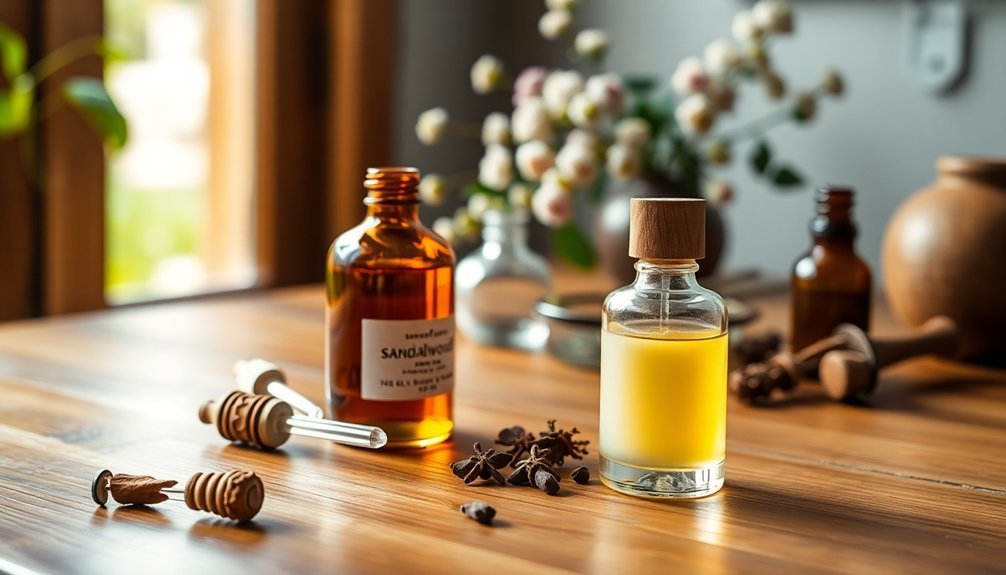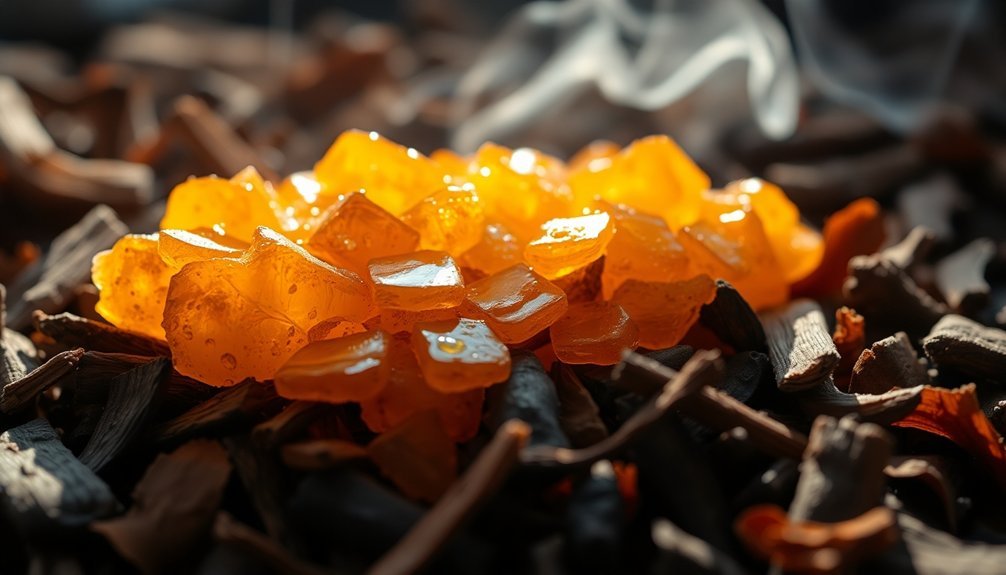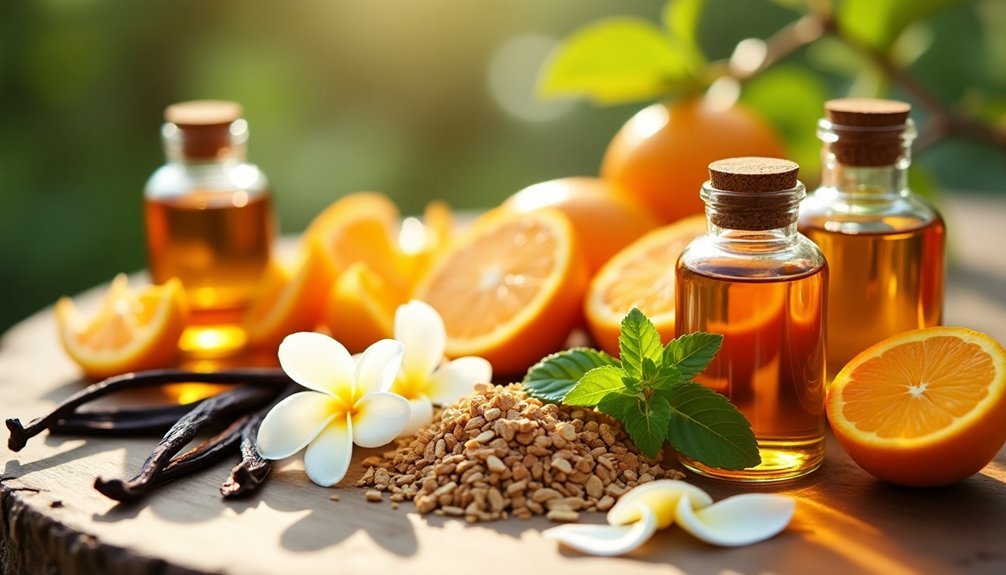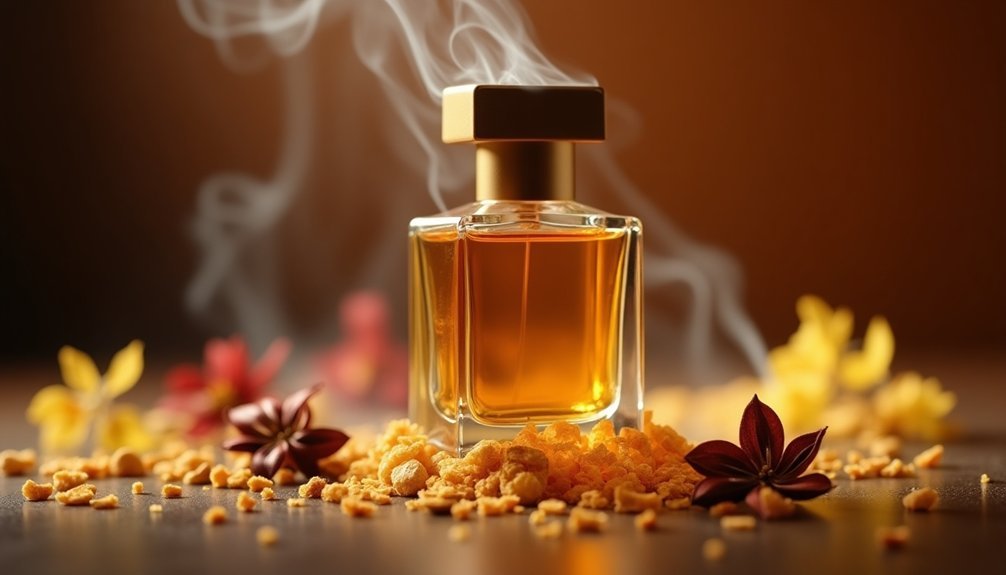The most coveted woody base notes for your homemade perfumes include sandalwood, oud, cedarwood, vetiver, patchouli, frankincense, and amber. You'll find sandalwood offers a warm, creamy foundation, while oud brings complex earthy depths. Cedarwood creates masculine appeal, and vetiver adds earthy anchoring. Patchouli transforms simple blends into masterpieces, frankincense delivers sacred depth, and amber rounds out compositions. Each note brings unique characteristics to help you craft distinctive signature scents.
Essential Sandalwood: A Creamy Foundation For DIY Perfumes

Treasured for centuries, sandalwood stands as one of perfumery's most luxurious base notes, offering a distinctively warm and creamy aroma that's both grounding and sophisticated.
When you're crafting homemade perfumes, you'll find its rich, earthy character brings remarkable versatility to your creations. Modern perfumery has seen over 600 launches featuring sandalwood notes in fine fragrances during 2020 alone.
You can blend sandalwood seamlessly with florals like rose and jasmine to add depth, or pair it with spices such as cinnamon and cardamom for an exotic touch.
It's particularly effective when combined with bergamot for brightness or white musk for seductive undertones.
As a fixative, sandalwood's sesquiterpenes help your fragrance last longer while lifting other base notes through the composition.
For your DIY perfumes, you'll appreciate how sandalwood creates a balanced foundation that's both soothing and complex, making it an essential ingredient in your perfumery toolkit.
The Deep Allure of Oud in Handcrafted Fragrances
When you explore oud in your handcrafted perfumes, you'll discover an ancient resin treasured in Middle Eastern spiritual practices for its deep, mystical qualities.
You'll find oud's complex profile combines earthy woods with sweet resins and leather-like undertones, creating an intensely sophisticated base.
The oil is obtained through steam distillation processes of infected Aquilaria tree heartwood.
To achieve the best results in your blends, start with a small ratio of 1-2% oud to your total composition, as its powerful presence can easily dominate other scent elements.
Origins and Sacred Uses
Deep within the rainforests of Southeast Asia, the mysterious aquilaria tree produces one of perfumery's most coveted ingredients: oud.
When infected by parasitic mold, the tree creates a dark, protective resin that's prized for its unique, smoky-balsamic aroma. This rare substance has been cherished across ancient civilizations, from China to the Middle East, for both its luxurious scent and sacred properties. The term "oud" originates from al-oud, meaning wood in Arabic.
Sacred uses of oud across cultures include:
- Buddhist meditation enhancement through essential oil steaming
- Japanese Kōdō ceremonies, where it marks spiritual journeys
- Arabian home purification rituals to dispel negative energies
- Ayurvedic practices for medicinal and relaxation purposes
You'll find oud's historical significance deeply rooted in royal traditions and religious ceremonies, where it's been valued for centuries as both a luxury item and a spiritual tool.
Complex Scent Profile Elements
Beneath its timeless allure, oud's complex scent profile reveals a symphony of interwoven elements that'll captivate your senses. You'll discover a deep woody foundation enriched with leather notes and resinous sweetness that creates an unmistakable signature in your homemade perfumes.
| Oud Profile | Complementary Notes |
|---|---|
| Woody Base | Sandalwood, Cedar |
| Leather Notes | Tobacco, Suede |
| Resinous Sweet | Vanilla, Amber |
| Earthy Balsamic | Patchouli, Vetiver |
| Animalic Notes | Musk, Ambergris |
When you're crafting your perfumes, you'll find oud's versatility shines through its ability to harmonize with diverse notes. Its exceptional longevity means your creations will last throughout the day, while its adaptability lets you experiment with florals, spices, or fruits to achieve your desired complexity.
Blending Tips and Ratios
To master the art of blending oud in handcrafted fragrances, you'll need to understand precise ratios and techniques that create harmonious compositions. When working with rose and oud combinations, start with a conservative 5% rose ratio and gradually increase it to find your perfect balance, up to 20-25% for Bulgarian or Turkish roses, or 30% for Taifi rose.
- Always begin with minimal amounts of each fragrance, testing small batches before scaling up.
- Use proper blending tools and a step-by-step approach to adjust ratios.
- Test your blend on skin and observe its evolution over several hours.
- Reference established perfumes like ROJA Taif OUD for guidance on professional ratios.
Remember to layer your notes strategically and include complementary ingredients like patchouli, vetiver, or ambroxan to enhance the woody character of your creation.
Cedarwood: Building Natural Masculine Blends
Cedarwood's timeless appeal makes it a cornerstone in crafting masculine fragrances. You'll find this warm, woody note derived from the Eastern Red Cedar Tree adds depth and sophistication to your homemade perfumes.
It's particularly effective when you're aiming to create lasting scents with a natural, masculine character.
To build your blend, start by combining cedarwood with complementary notes like Clary Sage, Bergamot, or Patchouli. You'll get excellent results pairing it with leather or tobacco accords for a rich, smoky effect.
When working with cedarwood, remember to add it during the base note stage and allow your blend to mature for several weeks.
Store your cedarwood oil in a cool, dark place to maintain its potent woody aroma, and you'll have a reliable foundation for creating sophisticated masculine fragrances.
Vetiver's Earthy Magic in Custom Perfume Making

When you're working with vetiver in custom perfumes, you'll discover its remarkable ability to anchor other scents with its deep, earthy-woody character.
You can blend vetiver oil effectively with sandalwood or patchouli for complex base notes, or pair it with citrus oils to create an intriguing contrast of fresh and earthy elements.
For the best results, source high-quality vetiver oil from reputable suppliers who offer different varieties like Haitian or Java, as each type brings its own unique characteristics to your perfume creation.
Properties and Blending Tips
While vetiver's deep, earthy aroma captivates perfume enthusiasts worldwide, its true magic lies in its versatility as a base note.
You'll find this remarkable ingredient acts as both a fixative and a complex scent builder, helping your homemade perfumes last longer while adding depth to your compositions.
When creating your custom scents with vetiver, consider these essential blending tips:
- Pair with florals like jasmine or rose for a sophisticated, balanced fragrance
- Combine with citrus notes to create an uplifting, fresh twist on woody scents
- Add spicy elements like cardamom or pepper for a warm, intriguing profile
- Mix with other woody notes such as sandalwood for enhanced depth
You can adapt vetiver for any season by adjusting complementary notes, making it perfect for both light summer fragrances and rich winter blends.
Sourcing Raw Vetiver Oil
Sourcing high-quality vetiver oil starts with understanding its complex production process. The oil is extracted through steam distillation, which takes 60-70 hours to complete and yields only 0.3-1.0% of oil from the roots.
When you're looking to purchase raw vetiver oil, focus on suppliers from major producing regions like Haiti, India, Java, and Réunion.
You'll want to verify that your supplier follows proper harvesting and processing methods. Fresh roots produce better oil, so ask about their harvesting timeline and storage practices. Look for oils extracted from roots harvested in December, when the crop is typically ready.
Since worldwide production is limited to about 250 tons annually, you might encounter varying prices and availability. Major perfume houses often secure large quantities, so consider working with established distributors to guarantee consistent supply.
Crafting With Patchouli: The Versatile Base Note
As one of perfumery's most prized base notes, patchouli brings an intoxicating depth that transforms simple fragrances into complex masterpieces.
This versatile oil matures like fine wine, developing from a light, fruity scent into a rich, woody aroma that's perfect for creating lasting perfumes.
When you're crafting with patchouli, you'll discover its remarkable ability to enhance various fragrance families while stabilizing your final creation.
Here's what makes patchouli an essential addition to your perfume-making toolkit:
- Pairs beautifully with citrus, floral, and sweet notes
- Acts as a natural fixative to extend your perfume's longevity
- Develops a more complex scent profile when exposed to light and air
- Offers therapeutic benefits, including stress relief and skin-healing properties
Frankincense: Adding Sacred Depth to Your Blends

Three thousand years of sacred tradition make frankincense one of perfumery's most treasured ingredients. When crafting your homemade perfumes, you'll find this golden resin from Boswellia trees offers a complex blend of woody, spicy, and balsamic notes that'll transform your creations.
| Scent Layer | Notes | Pairings |
|---|---|---|
| Top | Citrus, Pine | Bergamot, Orange |
| Middle | Spicy, Balsamic | Rose, Geranium |
| Base | Woody, Resinous | Myrrh, Oud |
| Dry Down | Sweet, Earthy | Vetiver, Amber |
You can source the highest quality frankincense by looking for golden-hued tears harvested from Somalia, Oman, or Yemen. When blending, start with small amounts – its intense aroma lasts for hours and beautifully anchors lighter notes while adding meditative depth to your perfume compositions.
Combining Woody Notes: Creating Complex Base Layers
While creating complex base layers requires careful consideration, mastering the combination of woody notes will elevate your homemade perfumes from simple scents to sophisticated fragrances.
You'll find that blending different wood notes, like sandalwood with cedarwood, creates a rich foundation that's perfect for layering with other scents.
- Start with a 5-10% concentration of base notes, mixing woods like patchouli and vetiver for enhanced longevity.
- Layer your woody base with spices or florals to add dimension and warmth.
- Incorporate musk or amber notes to boost the richness and staying power.
- Balance your creation with herbal middle notes like lavender or rosemary.
Remember to experiment with different ratios and combinations until you achieve the perfect harmony between your chosen woody notes and complementary scents.
Frequently Asked Questions
How Long Do Woody Base Notes Typically Last Once Applied to Skin?
You'll find woody base notes typically last 6-8 hours on your skin, but they can extend up to 12 hours if you've got oily skin or you're wearing notes like oud and patchouli.
Can Woody Notes Cause Allergic Reactions More Frequently Than Other Notes?
You might experience more allergic reactions to woody notes, especially from oak moss, which affects around 35-38% of tested individuals. Overall, woody fragrances can trigger reactions more frequently than some other fragrance types.
What's the Best Storage Method to Preserve Woody Essential Oils?
Store your woody essential oils in dark glass bottles with airtight lids at room temperature, away from sunlight. You'll want to keep them upright in a cool, dark place to prevent degradation and evaporation.
Which Woody Notes Work Best for Summer Versus Winter Perfumes?
You'll want lighter woods like cedar and cypress for summer fragrances, while winter calls for richer woods like patchouli and sandalwood. Light woods blend well with citrus, while deeper woods complement spicy notes.
Are Synthetic Woody Notes as Effective as Natural Ones in DIY Perfumes?
While synthetic woody notes can be effective and long-lasting in your DIY perfumes, they often lack the depth and complexity of natural ones. You'll find that combining both types creates the most balanced fragrance results.
In Summary
You've now got the knowledge to create incredible woody base notes in your DIY perfumes. Whether you're drawn to sandalwood's creamy warmth or oud's exotic richness, these seven foundational ingredients will transform your homemade fragrances. Don't be afraid to experiment with combinations – layer cedarwood with patchouli or blend frankincense with vetiver. Your perfect signature scent awaits in these timeless woody notes.
References
- https://anthonymarmin.com/the-perfume-blog/woody-notes-in-perfume
- https://www.lifenreflection.com/how-to-make-your-own-perfume/
- https://phlur.com/blogs/perfumery-dictionary/what-is-the-woody-fragrance-family
- https://jerrywbrown.com/wp-content/uploads/2018/05/San-Angelo-APSI-Language-2018-4.pdf
- https://www.esquire.com/style/grooming/g43520997/best-woody-colognes/
- https://quintis.com.au/q-lab-knowledge-centre/blogs/sandalwood-an-essential-ingredient-for-perfumers
- https://www.youtube.com/watch?v=YR4WNteRaAk
- https://pura.com/blogs/pura/the-alluring-aroma-of-sandalwood-what-does-it-really-smell-like
- https://www.alphaaromatics.com/blog/woody-perfumes/
- https://irfe.com/sandalwood-perfume/





Leave a Reply